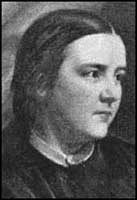Sophia Jex-Blake 1840 - 1912
 As Scotland’s first female doctor, she was arguably the most important figure in the women’s movement in Britain in 2nd half of 19th cent.
As Scotland’s first female doctor, she was arguably the most important figure in the women’s movement in Britain in 2nd half of 19th cent.
What justified that claim was her ultimately successful struggle for women to be admitted to universities in Britain on the same basis as men. The ground on which she chose to fight was the right of women to matriculate as students in the faculty of Medicine in the university of Edinburgh. Women, not unreasonably, thought that if they could break into this are then others such as parliament and the professions would then be open to them too.
However the campaign waged by Sophia and her supporters against one of the most deeply ingrained misogynist institutions in the country not only profoundly challenged male stereotypes concerning a women’s capabilities both physically and mentally, it also divided the women’s movement itself.
The policy of confrontation favoured by Sophia was opposed as adventurous and seen as wrong-headed by those women activists such as Elizabeth Garratt Anderson who wished to prove by example that they were equally as capable as men, given the opportunity.
The tactical disagreement between Anderson and Jex-Blake over direct action and peaceful persuasion in many ways pre-empted the division between the suffragettes and suffragists over attitudes to law and order in the early 1900s.
Sophia Jex Blake and her determination to succeed where others failed made possible the progress that occurred in the field on medical education for women. It was her hard work that galvanised opinion and support that finally convinced the government that a change on the law was necessary and essential.
It would not have been possible without the money provided by her mother and influential women in Edinburgh Society (such as Louisa Stevenson).
She achieved more for women in the field of medicine than Florence Nightingale – who has been awarded national heroic status. Difference is that Sophia challenged in a fundamental way perceived notions of femininity, Florence Nightingale as a ministering angel merely confirmed them. Sophia Jex Blake was opposed to married women becoming doctors and so in that way unwittingly underscored the traditional role of women as wives and mothers.
Sophia came from a privileged background – home tutored and hen sent on to Queens College (London) to study maths, English French, philosophy, theology and church history. Within a short time she was offered a teaching post in Maths.
A few years later she took up a post teaching English in Germany for 6 months. After that she went to the US and studied there.
She was struck by the need for female doctors finding that many women will suffer in silence sooner than give intimate details to a male one. She entered New York infirmary as a medical student in 1866 (after finding that some US institutions also barred females.)
She tried to continue her studies in Edinburgh but was denied a place, as women were not allowed to study medicine, in fact the men rioted to keep her out.
Women had only limited access to higher education through the Ladies educational associations that had been established in Edinburgh and St Andrews in the early 1860s. So women could attend classes in maths, botany etc take exams and receive certificates but it was clear that there were no links between education and the possibility of pursuing a career.
After canvassing all members of the faculty, the university approved ‘as an experiment’ her entry into Natural History and Botany classes. It was ambiguous whether she could sit an exam so she appealed to the Senate and won. However they then decided to end the ‘experiment’ on the grounds of the inconvenience of teaching one woman..
Sophia responded by gathering six others to apply to the faculty of Medicine, guaranteeing the fees. They won but the backlash was also there. First a professor refused to award and woman a scholarship on grounds that they were taught separately. Others followed with equally spurious reasoning. The women did very well in spite of this, but that in turn inspired more opposition and a grim determination to remove them.
She took it to court in 1872, it found in favour of the seven applicants, but the court of session overturned the ruling. It took an act of Parliament in 1876 to clear the way.
She founded the London School of Medicine for Women in 1874 but her abrasive nature prevented her from being elected as head. She completed her studies in Switzerland (1877).
Then she came back to Edinburgh and set up a practice at 4 Manor Place where she stayed for 20 years.
In 1886 she set up and became Dean of the Women’s Medical College in Surgeon’s Square and helped found the Edinburgh Hospital for Women and sick children (later the Bruntsfield Hospital) at High School Yards.
She is buried in Chambers Aisle in St Giles - away from the other Medics in the North Choir Aisle, reportedly as a consequence of her dislike of Elsie Inglis.
References:
William W J Knox: Lives of Scottish Women, Women and Scottish Society 1800-1980.
Photo from spartacus
